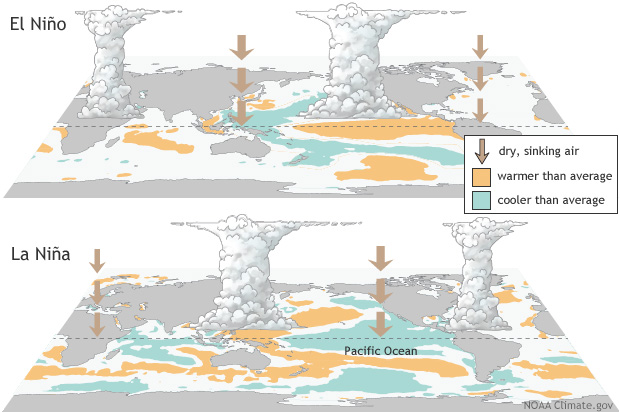The planet is alive with pulses of matter and energy on a huge range of spatial and temporal scales.They range from the nearly instantaneous travel of radiation, to pressure waves which travel through rock, water and air at several hundred meters per second, and slower cycles such as tides on the scale of hours (and weeks, depending on the moon’s phase), and weather systems on days, to say nothing of volcanic and tectonic processes. But large oscillations of currents,air and water pressure occur in and above the ocean, on the scale of thousands of miles. Their periods range from months to decades, and they can have dramatic global effects.
Over the next several posts I'll briefly introduce them to you. They are:
Antarctic Oscillation (AAO)
Arctic Oscillation (AO)
Arctic Multidecadal Oscillation (AMO)
Indian Ocean Dipole (IOD)
Madden-Julian Oscillation (MJO)
North Atlantic Oscillation (NAO)
North Pacific Gyre Oscillation (NPGO)
North Pacific Oscillation (NPO)
Pacific Decadal Oscillation (PDO)
Pacific-North American Pattern (PNA)
Since ocean water has roughly 3,000 times the heat capacity of air, the ocean's dominant effect must be included in any analysis of global weather and climate patterns.
Schematic of El Niño and La Niña.
A quick review here of the best-known of all oceanic oscillations: the El Niño-Southern Oscillation (ENSO). These are coupled oceanic and atmospheric variations. In an El Niño phase—named for its appearance around Christmastime—an equatorial current of warm water flows east from the western Pacific to the coast of South America. At the same time the Southern Oscillation Index (SOI) involves comparing air pressure measurements at Darwin, Australia (central Pacific) with Tahiti (western Pacific). A negative SOI is strongly correlated (though not 100%) with an El Niño event. La Niña usually occurs when the SOI is positive and involves cold water upwelling in the eastern equatorial Pacific and flowing west.
The rise of warm air above the warm current in the eastern Pacific during El Niño leads to wet conditions along the equatorial Pacific, in the southern United States, and zones in Africa and eastern South America. La Niña produces warm rainy weather in the western Pacific and northern South America, and warm, dry weather across the southern United States.
Global effects of La Niña.
Tomorrow: The Antarctic oscillation (AAO).
Be brave, and be well.








No comments:
Post a Comment